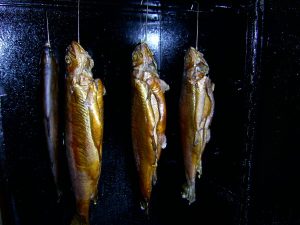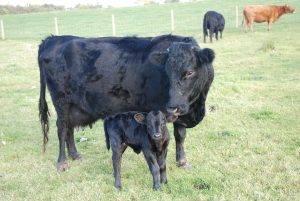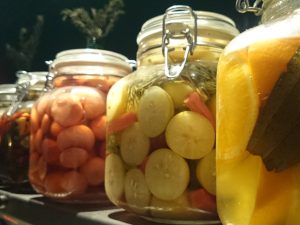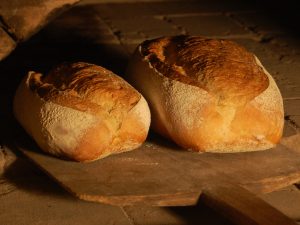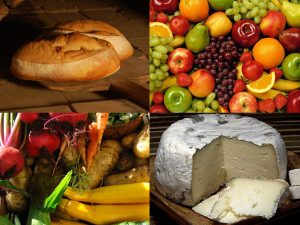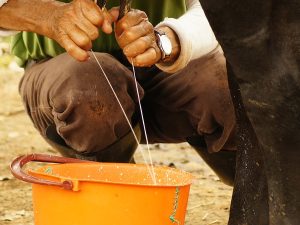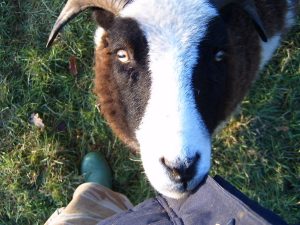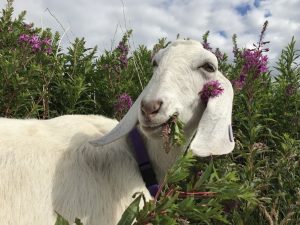Cheesemaking - introduction
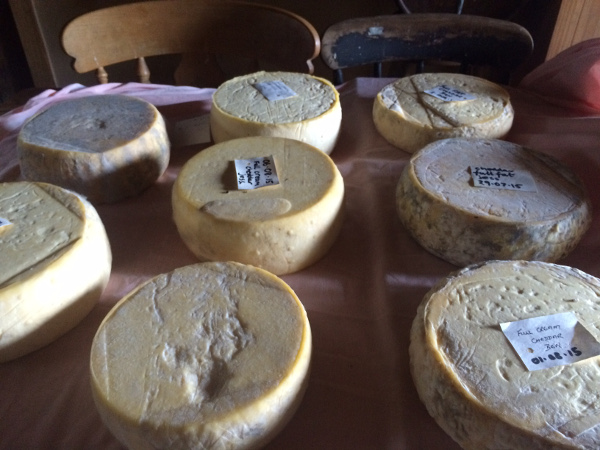
“Blessed are the cheesemakers.” – Monty Python
Contents
What is cheesemaking?
Cheesemaking is using the protein and some of the fat and mineral salts from milk to make something that keeps better than milk does. It’s a way of preserving the milk by taking most of the moisture out. Cheese was the first ‘convenience’ food, and it was probably first properly made around 5000 years ago in the Middle East. We can’t be 100% sure, but vessels from that era have been found that look as though they were for draining curd. Certainly the ancient Greeks and Romans were making sheep’s cheese, there are a couple of mentions of cheese in the Bible, and there have been finds of draining vessels from pre-Roman Britain.

Making cheese was an efficient way of storing milk protein for when there wasn’t much milk around, and in the Medieval period it was a useful source of protein through the winter. Cheese has also been made from cow’s milk for a long time. Until the 19th century, all cheese was ‘farmhouse’ – i.e. made on the farm; but then big factories started making large quantities of cheese. During World War II, a standard recipe was used to produce as much cheese as possible, and a lot of farmhouse cheesemakers went out of business. Very little farmhouse cheese was made during the 50s and 60s, but since then, interest has increased and there are a lot more farmhouse / artisan producers now.

In all cultures where milk is part of the diet, cheese is also made. The type of cheese depends on the climate and the type of milking animal available. In India, vinegar or lemon juice is used to coagulate hot milk to make paneer cheese (a suitable process for a hot climate with no refrigeration). Mediterranean cheeses tend to be either hard (like Parmesan) or salty (like feta), because they keep better in a warm climate.
Curd is the solid produced either by heat and acidity, or the addition of rennet. It contains a lot of milk protein, milk fat, salts and the remaining lactose. Whey is the liquid remaining either when acid is used to coagulate the curd, or when renneted curd is cut. Cheese keeps because a) it’s acid, b) it doesn’t contain much moisture, and c) it has salt added.

There are 3 basic types of cheese. The simplest is made by adding an acid (e.g. lemon juice) to hot milk – curd is formed immediately and the whey can be strained off. This type of curd cheese doesn’t keep very well. This simple type includes paneer, and a few specialist cheeses, and not much is made commercially.

The second is made using a starter and rennet, and it’s the way that most cheeses are made. A lactic-acid-producing bacteria (starter) is added to warm milk, and then adding rennet makes the milk go solid (rennet is a mix of enzymes from animals’ stomachs, but there are vegetarian / plant-based rennets as well). The solid milk can then be spooned into moulds to make soft cheese, or can be cut with a knife (which releases whey), and then stirred and heated gently to make hard (pressed) cheese.
The third type of cheese is made using the whey produced from the second type to make ricotta cheeses. The whey is heated to near boiling point, adding extra milk if required, and then the soft, white solid that appears is skimmed off. Mysost cheeses (‘whey cheeses’) are made by boiling down the whey until a solid residue is left. Actually, this third type of ‘cheese’ is not strictly speaking a true cheese as it contains no casein.

Most soft and hard cheeses are variants of type 2. With soft cheeses, the curds and whey are spooned into moulds and the whey drains on its own. With hard cheeses, the curds are cut and the whey released, then the curds and whey are stirred and heated, and then pressed.
Moulds (penicillium) can be added to produce blue veins, or the white overcoat of brie-type cheeses. These are soft or semi-soft cheeses (Stilton isn’t pressed), and the moulds are added purely for taste. Cottage cheese is also a variant of type 2, as it starts life with a starter and rennet. The curd is cut, and when the pieces of curd start to harden they are chilled in very cold water, which stops them from sticking together.

What are the benefits of cheesemaking?
- cheese is an excellent source of protein, energy and calcium
- it’s also an efficient way of keeping milk protein safe and preserving it over time
- it’s a versatile and useful food – all of it can be eaten, and it’s called for in many recipes
- hard cheese is the only high-protein, ready-to-eat food that doesn’t require refrigeration, thereby saving energy
- people who are lactose-intolerant (possibly the majority of the world’s adults) are often fine with cheese, as most of the lactose has been converted to lactic acid
- whey is an acidic by-product that can be used as a raising agent when making scones etc.
- cheesemaking can be an interesting hobby, especially if you have your own milking animals; it can be a valuable food and income source for a smallholding, and if it all goes horribly wrong, it can be fed to pigs – they love it
- a hobby can develop into a small, local business, and hopefully cheeses can once again become mainly farmhouse / artisan and unique
What can I do?
Start your cheesemaking with something simple – just add lemon juice or vinegar to hot milk. Next have a go at soft cheese, and only then attempt hard cheese. It’s a good idea to go on a course, to get a feel for it first. If you’re buying milk to make cheese, get either unpasteurised or pasteurised (but not sterilised) full-fat milk. It’s also better if you can get non-homogenised milk – i.e. from a small producer, as larger dairies (that supply supermarkets) tend to homogenise, so that there’s no cream line. The milk and cream are separated, some of the cream is taken away (for cream or butter), and the rest is broken up into much smaller globules and put back into the milk. Ideally, find a small dairy – a lot of them are now selling bottled, non-homogenised milk. It’s more difficult to make cheese if the milk is homogenised, but not if it’s goat‘s or sheep‘s milk, which is naturally homogenised – and much easier to obtain unpasteurised. Unpasteurised cow‘s milk is much more regulated. The milk needs frequent testing and it’s not allowed in areas where bovine TB is common.

To make cheese domestically all you need is a kitchen that’s easy to keep clean and can be pet-free when you’re making your cheese. Also, avoid making bread, beer or jam at the same time, because there are moulds and yeasts in bread, beer and fruit that cheese doesn’t like. Normal kitchen cleanliness is adequate. To make cheese commercially, contact your local environmental health department and seek their advice before you start. You’ll need suitable (easy-clean) premises, and you’ll need to keep records and be inspected. If you’re making soft cheese, you’ve probably got all the kit already. For hard cheese you’ll need to buy or improvise some moulds and a press. You can find cheesemaking recipes in books and online (see resources).

Storing hard cheeses may be a problem (other types should be eaten quickly). Fridge temperatures are too low for hard cheeses to mature, and room temperatures are too warm. You need a cool place to store them, where they’ll be safe. The cheese will need to be protected as it matures. You can get wax (think Edam) from smallholder suppliers, and then the cheese won’t need turning. A lot of farmhouse hard cheeses are matured on the rind – i.e. the outer surface dries and goes hard. These cheeses need turning daily. Paint-on coating is also available from smallholder suppliers, and they need turning too. Or you can vacuum-pack the cheese. They won’t need turning, and it’s possibly the safest way to cover small cheeses.
Specialist(s)
Thanks to Judy King of Wharf Farm Dairy for information.

